Some Productions are Best Left Unheard
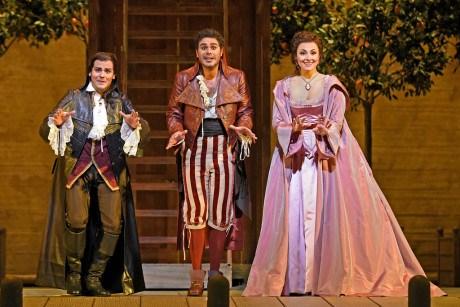 Almaviva (David Portillo), Figaro (Elliot Madore) & Isabel Leonard (Rosina) in The Barber of Seville (Photo: Karen Almond)
Almaviva (David Portillo), Figaro (Elliot Madore) & Isabel Leonard (Rosina) in The Barber of Seville (Photo: Karen Almond)
There’s a lot happening lately over at Lincoln Center Plaza in New York, as well as right here in our little hometown of Raleigh. Some events are, by their physical proximity, fairly easy to get to; others are much too far away. But wherever they take place, hearing and seeing opera takes precedence (for this opera buff, at least).
Let’s take the Metropolitan Opera, if you please. Last season, the house was plagued with a relentless flu epidemic that devastated the carefully programmed Saturday matinee broadcasts. One had to keep away at all costs. The miserable wintry weather was partially to blame. Such as they were, both these unforeseen eventualities left their mark on the casts of several important revivals, among them Bizet’s Carmen and both Verdi’s Don Carlo and Un Ballo in Maschera.
Nevertheless, the shows went on as scheduled. This season, with a milder than average early winter and relatively pleasant daytime temperatures (that drastically changed this weekend, as we all know), the Met broadcasts have been entertaining, for the most part, and without incident.
Still, my own feeling about some productions is that they are better left unheard. By that statement, I mean that the Met Opera’s revival of Rossini’s The Barber of Seville, on December 26, 2015 (known in England as Boxing Day), happened to be the company’s sliced-and-diced and everything-is-oh-so-nice, English-language concoction by poet, librettist and literary critic J.D. McClatchy. This is one presentation that, by its very nature and execution, I needed to pass up.
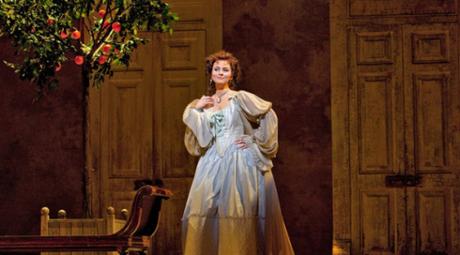
Having written at length about this version in a prior post (see the following link: https://josmarlopes.wordpress.com/2013/01/02/opera-review-the-barber-of-seville-in-english-shave-and-a-haircut-two-bits/), and blown my own gasket over its egregious cuts to such sure-fire elements as Don Basilio’s “La calunnia” and those marvelously timed Rossinian ensembles, I can only state the obvious: this is no way to woo young audiences over to opera.
With that bit of frustration put to rest, let me add that Rossini’s masterpiece is easily and without reservation his most admired work by far. It’s been in the public eye for well over two centuries, and has lost none of its sheen or its ability to gladden the ear and lift the spirit with those sparklingly inventive melodies.
The Barber has firmly established itself as a paean to popular culture, with Figaro’s entrance aria, “Largo al factotum” (“Make way for the jack-of-all-trades”), having long ago joined the ranks of Carmen’s “Habañera,” Escamillo’s “Toreador Song,” and Alfredo and Violetta’s “Brindisi” as the most frequently played of operatic numbers.
Our own North Carolina Opera will be staging The Barber of Seville this coming April 2016, which I will be looking forward to attending. Readers can be assured of a much longer treatment and review when the time comes. For now, I’ll refrain from further comment.
I do want to mention the Met’s radio cast, which included the resourceful Rosina of Isabel Leonard (she’s made a career out of this part, along with the trouser role of Cherubino in Mozart’s The Marriage of Figaro), tenor Taylor Stayton as Almaviva, baritone Elliot Madore as Figaro, bass Valeriano Lanchas as Dr. Bartolo, and bass Robert Pomakov in what was left of the reduced role of Don Basilio. Anthony Walker was the conductor in Bartlett Sher and Michael Yeargan’s colorful production.
A “Bat” Not Worth Taking
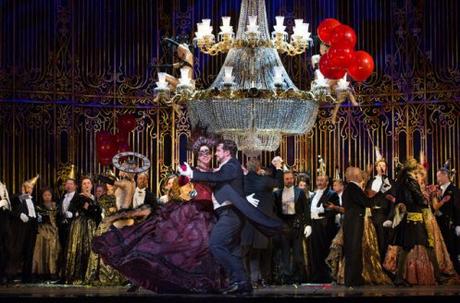
One opera I missed last year, but this time got to hear in full was the live January 2, 2016 broadcast of Johann Strauss Jr.’s Die Fledermaus, in another English-language presentation translated by producer Jeremy Sams (lyrics) and Douglas Carter Beane (dialogue).
For the background and plot of this riotous work, please see my previous review of this production when it was new (follow the link: https://josmarlopes.wordpress.com/2014/02/09/die-fledermaus-eugene-onegin-and-lelisir-damore-tragedy-tomorrow-comedy-tonight-a-triple-threat-at-the-met/). Suffice it to say, I am far from waxing enthusiastic over this piece. Although it was a favorite of Old Vienna and neighboring venues in its glory days, the forced sentiments and comedic double-dealings (including outright attempts at cuckolding) are somewhat passé by modern standards. You’ll find about as much if not more dirty laundry by tuning into any episode of Keeping up with the Kardashians.
In any case, the Met put its best foot forward by having their beloved music director, ailing maestro James Levine, preside on the podium. The move, in my view, was strictly overkill. His legendary care and accustomed expertise was in no way challenged by the frothy, lighthearted requirements of Fledermaus. We’re not talking Wagner here, or Richard Strauss (no relation to Johann) or Mahler, nor even Schoenberg or (heaven help us) Bernd Alois Zimmermann, whose unbelievably bombastic and immensely orchestrated Die Soldaten (“The Soldiers”) has become in recent years the surprise hit of European opera houses.
But enough about Europe, let’s get back to Manhattan (which, in 2008, mounted a production of Die Soldaten at the Park Avenue Armory) and the broadcast performance of Die Fledermaus, which starred Susanna Phillips as the wacky accident-prone Rosalinde, Lucy Crowe as the chirpy maid Adele, and Susan Graham (always a welcome and valuable presence) in the walk-on part of Prince Orlofsky, another trouser role.
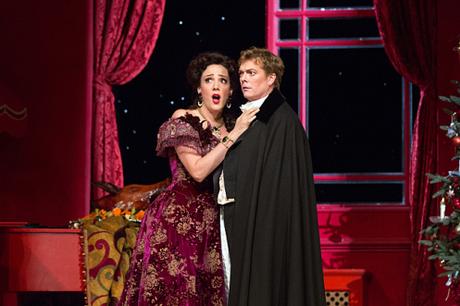
On the male side of the ledger, we have British tenor Toby Spence as Gabriel von Eisenstein, Dimitri Pittas as Alfred the Italian singer, Paulo Szot as Dr. Falke, the titular “Bat” of the opera, Alan Opie as prison director Frank, and Broadway actor and comic mime Christopher Fitzgerald as the drunken turnkey Frosch. How could you miss with a talented crew such as this? Well, let me count the ways…
Seriously, this was a most distressing affair, topped by a total waste of Levine’s talents. Sure, there were individual bright spots and moments of sheer orchestral delight. But they were too few and far between to be effective over the long haul, and clearly unnecessary in a work that tends to play itself. A lively overture and a Ländler waltz or two simply weren’t enough to merit the maestro’s presence. As I mentioned above, this isn’t Wagner, but Fledermaus is a long enough opera to slog through without having to put up with one-too-many dull spots.
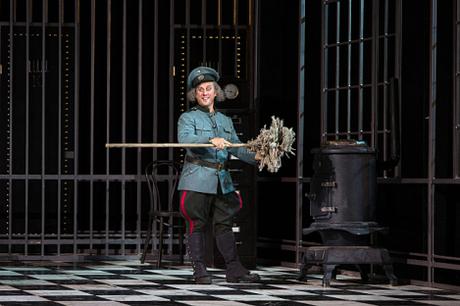
Back in the mid-1980s, Otto Schenk’s tradition-bound production of Die Fledermaus (along with an old-fashioned Ring cycle and an attractively adorned Tannhäuser, which we will soon be hearing) was a clear Met audience favorite. It at least mixed an authentic Viennese flavor with vintage champagne, principally in the New Year’s Eve party and jailhouse sequences. Schenk himself put in an appearance and made a particularly raucous and funny Frosch. But the jokes and hijinks in this American-English version fell flatter than a cheap bottle of imitation Dom Perignon.
At the least, Christopher Fitzgerald got some mileage out the “inebriated jailor,” an old routine as old as vaudeville itself. He joined such past cut-ups as Sid Caesar, Jack Gilford, Dom DeLuise, and Danny Burstein. Fitzgerald even offered a bit of leftover schnapps to hopeful audience members, which delivered a goodly number of guffaws from the crowd. Of the two soprano leads, Ms. Crowe got the loudest applause for her stratospheric coloratura turns as Adele, while Ms. Phillips proved the more adept at a flowing cantilena line in the part of the scheming Rosalinde.
However, Susan Graham’s take on the pokerfaced prince (as Earth Mother, mind you) left me cold. She appeared wearing a white fright wig, which made her a dead-ringer for Siberian baritone Dmitri Hvorostovsky. Well, why not? Orlofsky is supposed to be a Russian prince, but this sort of cartoonish display can quickly get out of hand (considering the current state of Hvorostovsky’s health). I’m sure everyone got the joke the first time around. How I long to hear someone as classy as Ms. Graham in a truly praiseworthy part: as Dido again in Berlioz’s Les Troyens, or Charlotte in Massenet’s Werther. Oh, the pain…
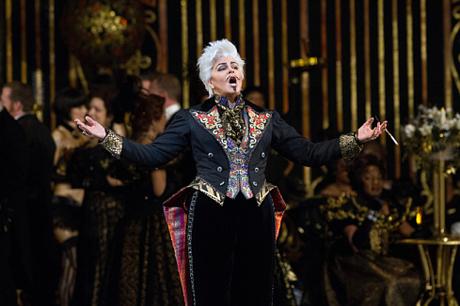
Another waste of a talented performer’s time and talent came with Brazilian baritone Paulo Szot’s limited assignment as Dr. Falke. With no major solo to boast of or anything worthwhile to show off this classically trained singer’s artistry, Mr. Szot melted into the woodwork, as did Mr. Opie’s smoothly vocalized Frank and Spence’s veddy British Eisenstein (here excruciatingly called “Gay-bree-el” by the cast members).
Queens native Dimitri Pittas’ exuberance as Alfred, the lovesick and highly-strung tenor, overcame his apparent struggle with the part’s requisite high notes. Those top A’s poured forth with some effort and were anything but easily produced. He did display a winning comic persona, which was small comfort indeed in what was essentially a not-so-festive atmosphere.
(To be continued…)
Copyright © 2016 by Josmar F. Lopes

